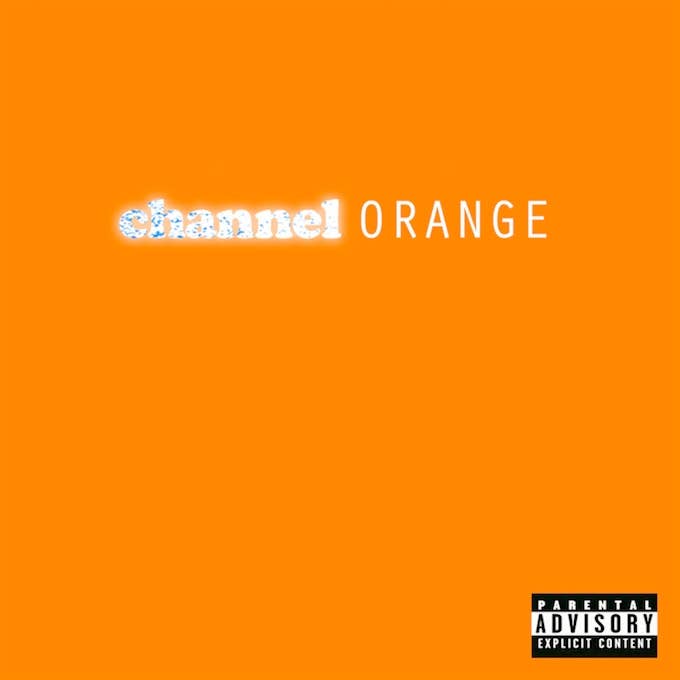
Everyone deserves the opportunity to imagine a future that feels right for them. Prince Rogers Nelson must hold some record for freeing the imaginations of freaks who could not glimpse a way forward before seeing him, all purple. Christopher “Lonny” Breaux was a self-conscious youth in New Orleans testing the range and volume of his pinched tenor (and annoying his mom in the process) when “The Beautiful Ones” split open a hole in space-time for the kid to hop through. His life as Frank Ocean awaited.
“I discovered Prince at my mom’s friend Jheri’s house,” he explained in a three-way interview with French composer Christophe Chassol and veteran American R&B producer Om'Mas Keith, for his glossy magazine Boys Don’t Cry. “I vividly remember the first time I heard ‘Beautiful Ones’ and this grown man singing for his life. Immediately I remember it clicking like, Oh, it’s okay to holler and scream and everything. Like, express yourself kid...go off! So yea, Prince basically made it all okay.”
On July 10, 2012, Frank Ocean put out Channel Orange, and five years later there is already evidence that, within R&B especially, his music has made it okay for young artists to envision new possibilities for songwriting and album construction. Singer-songwriters like Gallant, SZA, Choker, Daniel Caesar, Brent Faiyaz, Ravyn Lenae, and Khalid make music in a post-Ocean present. (SZA and Choker have cited him in interviews; Khalid has covered Ocean twice in the last few months.) Projects as discrete as Ctrl, Ology, and American Teen try for, and sometimes succeed at, Ocean’s conceptual, emotionally intelligent songwriting, high-wire metaphor work, fantastical scenes, images, and storytelling, and highbrow taste.
Days before Channel Orange’s release, Ocean shared a message on his Tumblr page that must have created futures for young people across the world in the most literal way. In prose colored by “portentous adolescent drama,” as Tavia Nyong’o put it so well, Ocean recalled falling for a young man as a teenager who did not return that love. “It was my first love, it changed my life,” he wrote, before concluding that “I don’t have any secrets I need kept anymore.” Freed to the world, that honesty alone changed lives, but had the note never been written Ocean’s music would’ve still redirected the genre.
R&B had room for new life at the end of the aughts. (I’m working from an inclusive, spiritual understanding of the genre that has everything to do with emotional candor and maximalism more than a consistent style of instrumentation or production. Like Amiri Baraka said, “R&B is about emotion, issues purely out of emotion.”) The bond between The-Dream and Tricky Stewart, which, along with the Neptunes, Timbaland, the Soulquarians, and Jermaine Dupri, shaped the most vital, genre-defining work of the 2000s, began to fracture around 2010’s Love King. With space for fresh visionaries, along came Frank Ocean and the Weeknd. Processed together, they presented a stylistic forking path, as Nitsuh Abebe observed. Still, both are indebted to The-Dream and Tricky: the latter signed Ocean in 2009, to Def Jam, and worked on his debut; early Weeknd loosies, like “Birthday Suit,” are Terius Nash imitations.
Frank Ocean’s mothers and fathers are many, and extend well beyond those who put him on. Missy Elliott’s borderless imagination and Afrofuturist revelations birthed him. Michael Jackson’s blockbuster ideas and cultish extravagance birthed him. André 3000’s sometimes goofy romantic philosophizing on The Love Below in particular. Kelis’s fearless eccentricity. Janet Jackson’s finesse with an interlude and sequencing. Prince and The-Dream, of course.
In February 2011, Ocean posted his first project, the mixtape Nostalgia, Ultra, to Tumblr while living and working in Los Angeles, where he relocated after Hurricane Katrina dashed his recording aspirations in New Orleans. In L.A., while honing his skills by writing tracks for established artists like Brandy, Justin Bieber, and John Legend, Ocean put Nostalgia, Ultra together. Another creative cohort, Tyler, the Creator, summed up the tape: "It's Smooth Ass Music About Bitches, Relationships And Being A Rich Young Nigga . . . But In A Swagged Out Way." It introduced major elements of Ocean’s style: a genuine interest in non-musical art, including cinema (“LoveCrimes”), descriptive and clever storytelling (“Novacane”), a developing social consciousness (“American Wedding”), and a unique, eye-catching aesthetic (the hobbyist’s cars and samurai imagery in the “Swim Good” video).
When Channel Orange arrived a little over a year later, 24-year-old Frank leveled up. Instead of relying as heavily on samples and the work of others to create meaning, he began to construct his own universe. You could move into the album, occupy the vantage of one its many characters to survey a landscape of crushed crack vials, glowing hot pipes, and family that’s forever receding; a strip club that wormholes between a lustrous ancient Egypt and dingy Southwestern America; tasteful modern homes built into near-coastal California hillsides where mutely blue TVs glow in unoccupied rooms because everyone inside is passed out and the ones still drug-alert are eyeing the poured concrete distance between the second-floor balcony and the swimming pool below.
Stop thinking of this as being music—this is world building. Frank Ocean’s chief collaborator on Channel Orange, producer Malay, said as much himself: “He’s the true storyteller…. He’s so good at creating these entire worlds.”
Less careful critics heard bleakness in Ocean’s music that echoed the Weeknd’s solipsistic narco-erotics. But for as often as the characters Ocean drew did their best to manage loneliness and mindless pleasure-seeking—the sunny side of addiction—Ocean’s music made time for corporeal and domestic pleasures too, even if melancholy coursed underneath the surface, like on the wistful but sweet “Sierra Leone.” The chorus-less song doesn’t behave like pop, and in two-and-a-half minutes convincingly whisks the listener from condom shortage to conception to the inside of a relationship and the room where a young father watches his child breastfeed: “Our daughter's reaching for your nipple cause it's time for her to eat/Tonight I'll lay her in the cradle if it's time for go to sleep.... Baby girl if you knew what I know,” he sings. You feel it all over.
What makes Frank a singular talent is that he retains total access to the emotion R&B is steeped in—the emotions that R&B can’t exist without—while also bringing a rich sense of intellectual imagination to his songwriting. The emotions brought on by unrequited love or desperate, make-do intimacy are legible beneath the wordplay and metaphor and narrative. His writing never forgoes details of race, sexuality, religion, or class. The surface of these songs, as enjoyable as they are, are never smooth, but always dappled and grained with texture—they don’t sacrifice mess and sprawl in the name of accessibility.
By no means a populist, Frank and his character creation can make the real Frank seem fundamentally distant in his art—that good Baraka line on black cool comes to mind: “In a world that is basically irrational, the most legitimate relationship to it is nonparticipation”—until his voice reaches into your chest and collapses the distance. This is what happens on a song like “Bad Religion” or “Wither,” where his craft no longer seems crafted; you hear the effort and strain when he sings. (Like all the real R&B singers, Ocean knows his gospel and that “the spirit will not descend without song”: you can find songs from Houston’s Kim Burrell and Oakland’s Daryl Coley on a playlist included in the pages of Boys Don’t Cry.)
Ocean’s critics, I think, find his voice thin, his production too left-of-center showy, and his extracurricular interests and influences pretentious, like a well-groomed but try-hard college student. And when post-Ocean artists dabble superficially in his style, the results can have the flavor of artifice without substance. Gallant’s “Miyazaki” is a good song, with a dope Groove Theory interpolation, but there appears to be no meaning gained from using the surname of Japan’s most beloved director of animated films. And when you take big swings at heavy storytelling subjects, the material can get away from you terribly and quickly. Brent Faiyaz, for instance, makes strong throwback R&B with his group Sonder, but his recent solo loosie “Natural Release” is a cautionary tale. In under three minutes, it tries with utter seriousness to tell you about an abused woman who, by masturbating with a magazine, sets into motion her partner’s suicide by handgun. The song is fake-deep, what happens when Frank Ocean goes wrong. (See “Monks” for Ocean’s own example of this.)
SZA’s Ctrl is is the clearest indicator of how Channel Orange made space for a new generation of R&B artists to embrace complex storytelling, idiosyncratic references and, in SZA’s case, bracing vulnerability. Inspiration from movies, scratchy interludes that work thematically, whip-smart, vivid writing (“Picking up a penny with a press-on is easier than holding you down”), but instead of hiding her story in a sort of character-driven shell game, like Ocean does on Channel Orange, she sings her life to you untreated. Her explicitly autobiographical songwriting dovetails with Ocean’s direction on Blonde and the songs he’s released this year through his radio show.
Mid tier R&B is so fertile and mutable right now that a post-Ocean artist like Faiyaz is fodder for a traditional bump-and-grind savant like Jacquees. His song “Shot” samples Faiyaz’s drifting ballad “DSN” to create a poppy club track. Both songs are great and become even more interesting for the ways in which they overlap and diverge. Discussing the “state of R&B” by now is an eye-roll inducing exercise, since the conversation always assumes decline, or at least puts its participants in a defensive posture from the jump. The debate is a nostalgia-driven ruse unless it directs listeners attention ahead rather than backward. Pay attention and you’ll feel the doorways opening everywhere, like an M.C. Escher lithograph. The available futures are endless.

